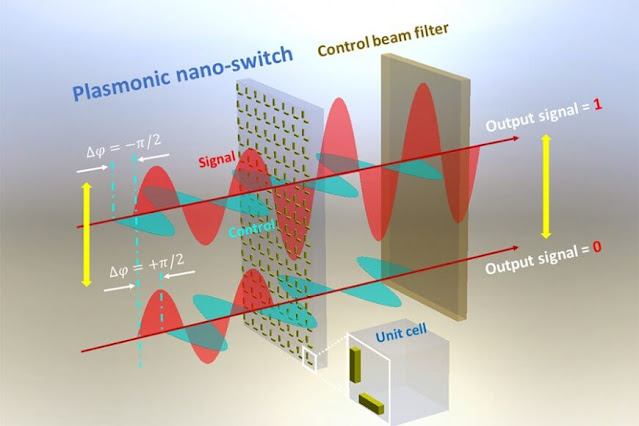.jpg) |
| all-optical switching Photo: Tampere University |
Photonics researchers have presented a new method for controlling one beam of light with another beam through a unique blank surface in a linear medium with very low energy.
This simple linear transformation method makes nanophotonic devices such as photonic computing and communication systems more sustainable and require low intensity of light.
The overall optical switching is the adjustment of the signal light due to the control of the light in such a way that it has the ON/OFF switching function. In general, a light beam can be modulated with another intense laser beam in the presence of a non-linear medium.
The switching method developed by the researchers is mainly based on the quantum optical phenomenon known as the enhancement of the refractive index (EIR).
"Ours is the first experimental demonstration of this optical system effect and its application to an all-optical linear transformation.
The research also enlightens the scientific community to realize lossy plasmonic devices operating at resonant frequencies through exceptional refractive index enhancement without using any acquisition media or non-linear processes," as says Humira Caglayan, associate professor (fixation pathway) in photonics at the University of Tampere.
Super fast optical switching enabled
High-speed switching and low-loss medium to avoid strong signal dissipation during propagation is the basis for the development of an integrated photonic technology where photons are used as information carriers rather than electrons.
To realize all ultra-fast on-chip optical switching networks and optical CPUs, all-optical switching must have ultra-fast switching time, ultra-low threshold control power, ultra-high switching efficiency, and nanoscale feature size.
“All digital electronic devices, including computers and communication systems, rely on switching between 0 and 1 signal values.
These electronic elements have gotten smaller and faster over the last few decades. For example, normal calculations performed with private computers Our on-call seconds couldn't do with old computers the size of a room even on several days!" Caglayan notes.
In conventional electronics, switching is based on controlling the flow of electrons over a time scale of microseconds (10-6 seconds) or nanoseconds (10-9 seconds) by connecting or disconnecting a voltage.
“However, by replacing electrons with plasmons, the switching speed can be increased to an ultrafast timescale (10-15 femtoseconds). Plasmons are a mixture of photons and a set of electrons on the surface of metals. This enables optical switching using our device at femtoseconds speeds (10-femtoseconds). 15 seconds).
“Our plasmonic nanoswitch consists of an L-shaped assembly of metallic nano sticks. One of the nano stocks receives a linearly polarized signal and the other receives another linearly polarized 'control' beam perpendicular to the first beam,” says postdoctoral research fellow Rakesh Dhamma, first author. for the article.
Polarization refers to the direction in which the beam's electric field oscillates. Depending on the phase difference between the beams, the control beam can attenuate or amplify the signal.
The phase difference is the time difference between when each ray reaches its maximum. Signal amplification occurs due to the transfer of some optical energy from the control beam to the signal through a constructive overlay with a carefully designed phase difference.
Improving the performance of plasmonic devices
Similarly, signal attenuation is achieved by destructive superposition when the beams have an opposite phase difference. This discovery makes nanophotonic devices such as optical computing and communications systems more sustainable and require a low intensity of light.
This simple linear switching method can replace current methods of optical processing, computing, or communication by accelerating the development and realization of plasmonic systems at the nanoscale.
“We expect to see further studies of plasmonic structures using our improved switching method and possibly using our method in plasmonic circuits in the future. Additionally, the L-shaped super surface can be studied further to detect high-speed switching under femtosecond laser pulse illumination and to investigate the enhancement of Nonlinear and controlled plasmon nanoparticles,” notes Humira Caglayan.
Nonlinear response control of nanostructures provides more interesting applications and functions for nanophotonic devices such as photonic computing and communication systems.
"This method has the potential to improve the performance of plasmonic devices by achieving broadband transparency of a signal packet without the use of a gain medium. It could open several avenues for designing intelligent photonic elements for integrated photonics," she explains.
The research received funding from the H2020 European Research Council (initiating the aQUARiUM grant project, the Academy of Finland Pioneer Program (PREIN), and the H2020 Research and Innovation Program (Marie Sk? Sklodowska-Curie MULTIPLY).
The research was conducted by members of the Metaplasmonics research group Rakesh Dhama, Tuomas Pihlava, Dipa Ghindani, and Humeyra Caglayan at TAU and guest researcher Ali Banah Pur.
Source:
Materials provided by Tampere University.
Reference:
Rakesh Dhama, Ali Panahpour, Tuomas Pihlava, Dipa Ghindani, Humeyra Caglayan. All-optical switching based on plasmon-induced Enhancement of Index of Refraction. Nature Communications, 2022; 13 (1) DOI: 10.1038/s41467-022-30750-5
